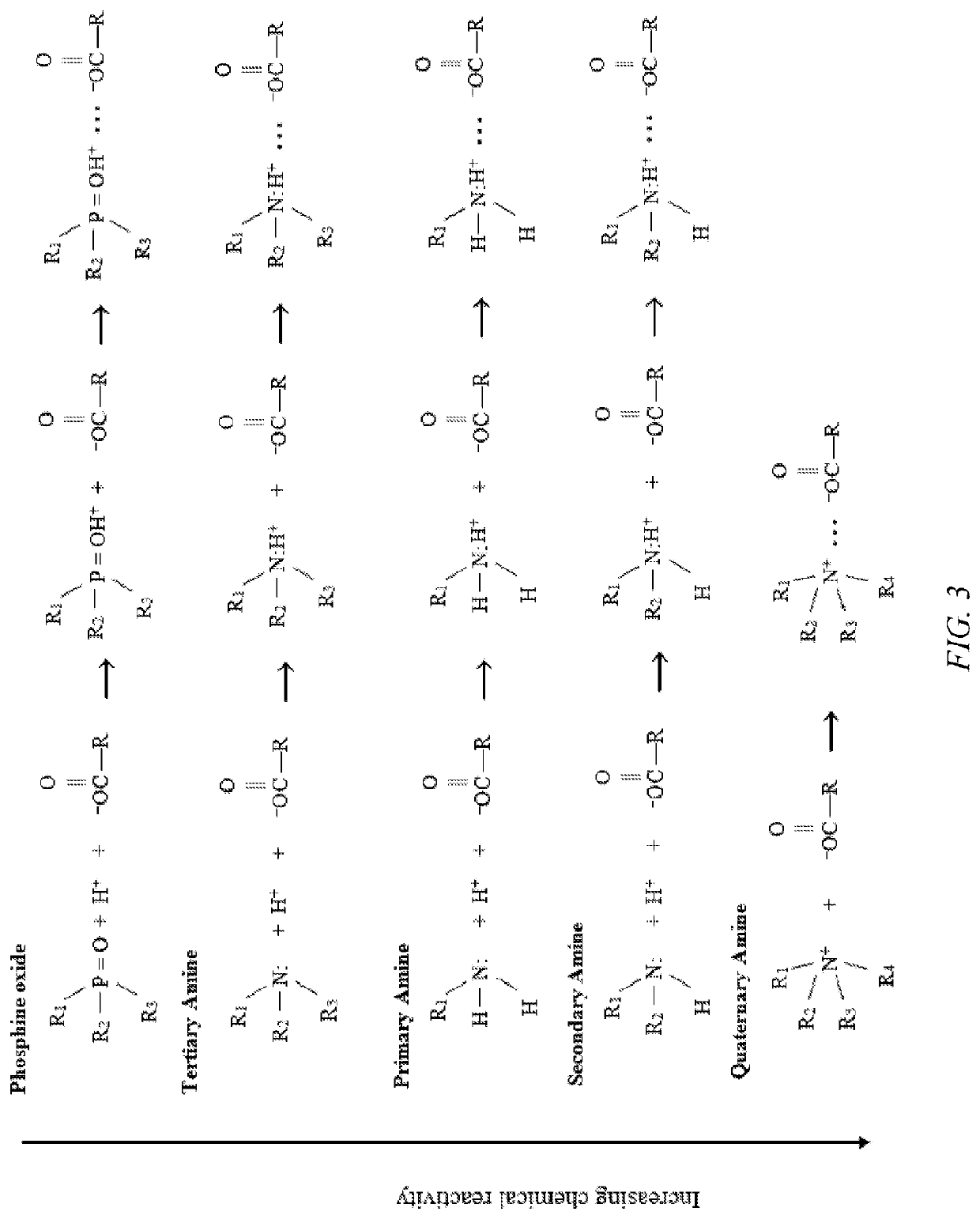Processes for converting biomass into high-value products
- Summary
- Abstract
- Description
- Claims
- Application Information
AI Technical Summary
Benefits of technology
Problems solved by technology
Method used
Image
Examples
example 1
sin
Part 1: Forward Extraction
[0392]A 1-L solution was made with 18.7 g / L of acetic acid. Pure CO2 was continuously sparged through the solution at atmospheric pressure. The solution was then titrated to a pH of 6.0 using MgCO3. After titration, 20 g of IRA 67 resin was added to the solution. The solution was allowed to mix for 2 h at room temperature. The final concentration of acetic acid in the solution was measured as 17.5 g / L. The final pH of the system was 6.5, an acceptable operating pH for the fermentor.
Part 2: Drying
[0393]The acid-rich resin from Part 1 was recovered by filtration. The resin was then allowed to dry overnight wrapped in filter paper. After drying at atmospheric pressure, the resin was placed in a round bottom flask and dried by vacuum and moderate heating. The resin decreased in mass by 60% upon the application of vacuum. This indicates that saturated resin is 60% moisture.
Part 3: Back Extraction
[0394]The dry resin was partitioned equally into 12 vials. Four ...
example 2
mine and Octanol Example
Part 1: Multi-Stage Extraction
[0396]A solution was made to closely model the fermentation broth by adding appropriate concentrations of several carboxylic acids and adjusting the pH to 6.0 with NaOH. The concentrations of each of the acids in the fermentation model are shown in Table E-1.
TABLE E-1Concentration of simulatedfermentation brothAcid AqueousTypeConcentration (g / L)Acetic13.93Butyric4.69Pentanoic4.70Hexanoic4.74
[0397]The model solution was contacted with extractant (0.15 mole fraction trioctylamine (TOA) and 0.85 mole fraction octanol) and shaken vigorously. Afterwards, the phases were separated and the extractant was repeatedly contacted with a new batch of aqueous phase. A gas chromatograph was used to analyze the acid concentration in each of the outgoing aqueous solutions. By using mass balances and summing each iteration of the experiment, the acid concentration in the extractant organic phase could be determined for a wide range of aqueous / orga...
example 3
36 Extraction
[0401]Aliquat 336 is a quaternary amine with a positive charge located on the central nitrogen atom. Because it is positively charged, it is sold as a salt with chloride ions. This salt is a very viscous liquid, so it must be diluted by a factor of 2 with decane, kerosene, or another alkane solvent. In this experiment, the Aliquat was diluted with dodecane.
[0402]A portion of the Aliquat / dodecane solution was contacted with 4-N aqueous NaOH at ratio of 2:1 aqueous:organic three times successively. This repeated contact with a concentrated, strong base replaced the chloride ions in the Aliquat solution with hydroxide ions.
[0403]The extracting ability of each Aliquat solution was tested in an identical manner. The organic phase was contacted in a 1:1 ratio with 10 g / L aqueous acetic acid solutions that had been titrated to a range of pH values with NaOH. The final aqueous acetic acid concentration was measured after each aqueous-organic system had time to equilibrate. For ...
PUM
 Login to View More
Login to View More Abstract
Description
Claims
Application Information
 Login to View More
Login to View More - R&D
- Intellectual Property
- Life Sciences
- Materials
- Tech Scout
- Unparalleled Data Quality
- Higher Quality Content
- 60% Fewer Hallucinations
Browse by: Latest US Patents, China's latest patents, Technical Efficacy Thesaurus, Application Domain, Technology Topic, Popular Technical Reports.
© 2025 PatSnap. All rights reserved.Legal|Privacy policy|Modern Slavery Act Transparency Statement|Sitemap|About US| Contact US: help@patsnap.com



